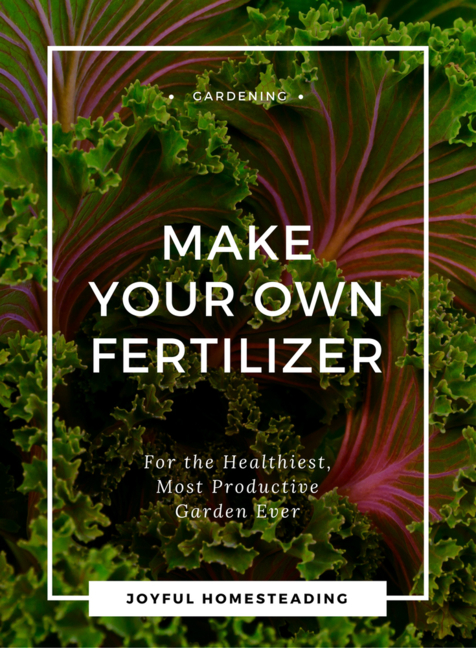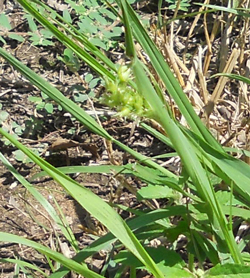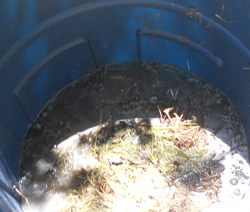Homemade Fertilizer
Homemade fertilizer is a great way to have quick compost even if you haven't built a compost pile. Here's how to make your own fertilizers for a stronger, healthier garden without chemicals.

When it comes to making your own fertilizer, you have a wide range of choices. You can make a liquid fertilizer. Or you can make fertilizer out of organic ingredients your garden loves, including coffee grounds or eggshells. Here are some great recipes to try.
Homemade Fertilizer Using Liquid Nutrients for a Garden Tea

Turn these nasty stickers into a quick compost that won't produce more goat head stickers.
I stumbled on this fertilizer recipe while trying to get rid of one of the most vicious weeds known to mankind - goat head stickers!
They're thick in our neck of the woods, and they're just awful; they
sting like the dickens when you get one stuck in your finger, and they
have a nasty way of attaching themselves to your socks, only to work
their way into your ankle or foot when you least expect it.
I've been spending a lot of my gardening time lately digging up these
weeds, but disposing of them was a challenge. I didn't even want these
awful weeds in my compost pile.
The thought of them sprouting and popping up in my garden at a later date was more than I could bear, but I also didn't like the idea of stuffing them into a plastic bag and adding them to the dump pile.
Burning them was out of the question as well. It tends to be hot and dry in Oklahoma in the summertime, and safe burn dates are few and far between. And besides, what do you do with them in the meantime?
How to Make a Liquid Homemade Fertilizer
What I finally decided to do with the nasty things turned out to be a boon for my garden, and hopefully a benefit for you as well. I figured out a fertilizer recipe that could make quick compost out of those nasty weeds. I've been using goat head stickers, but it will work with any weed from your lawn or garden.
I stuffed all the weeds I dug up (I've dug up about five wheelbarrow's worth so far) into a 55-gallon trash barrel and then filled the trash barrel with water. While I prefer black trash barrels for composting, the one I had available was blue, and it seems to work just as well. You want a dark color because it absorbs the heat better and can more easily heat the weeds and water inside.
I put the lid on the trash barrel and then let it sit in the hot sun for
three full days.
I would really recommend keeping the lid on tight because trust me,
it's going to stink and attract flies, but the end result is well worth
it.
At the end of three full days, draw off the water with a bucket.
This is your liquid homemade fertilizer.

To add it to your garden, take a small garden hand shovel and dig a small trench around the plant and as far from the plant itself as it is tall. So for example, if your tomato is two feet tall, you want to dig a trench in a circle about a two-foot radius from the plant.
This will keep your homemade fertilizer from burning the plant and also
get it to where your plant can access it the most easily - where the
delicate end roots are located that take in nutrients for your plant.
Add this quick compost to plants in your garden that aren't producing
enough, are doing poorly, or are being attacked by pests. Then add the
remaining solid matter to your compost pile where it will continue to
break down and make even more rich soil for your garden.
You'll have a stronger, healthier garden in no time!
Homemade Fertilizer Using Coffee Grounds or Eggshells
Use old coffee grounds to make a fertilizer your acid-loving plants will thrive on. Coffee isn’t just good for giving you a caffeine boost. Your garden loves it too. Used coffee grounds are loaded with potassium, nitrogen, and phosphorus. They’re also organic, meaning they provide aeration and drainage for your soil.
To make a fertilizer using coffee grounds, save your old grounds in an airtight container. When you’ve collected enough to cover a cookie sheet, line the sheets with old newspapers or used paper towels. Spread out the grounds and allow them to dry. Then sprinkle the grounds around the base of your strawberry and other acidic plants.
Eggshells are loaded with calcium carbonate, one of the main components of agricultural lime. Save eggshells instead of throwing them away. Allow the shells to air dry and then grind them in your blender until they’re powdery. Sprinkle the powder around the plants in your garden.
Learn More About Organic Gardening







New! Comments
Have your say about what you just read! Leave me a comment in the box below.